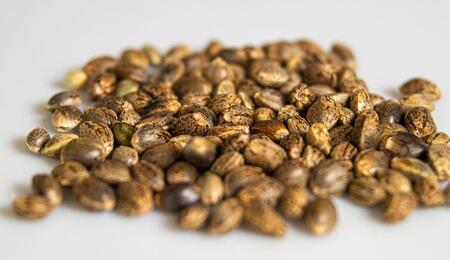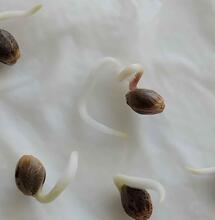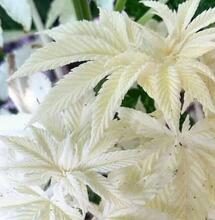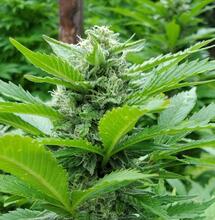Seeds and Needs

Imagine that you were going to pack up a Cannabis plant and transport it through space and time - there are some changes that could be made to an average plant that would help. For ease of transportation, and reduced shipping costs, it would be nice to minimize the size of the package. Limiting the number of roots would also help. As anyone who has rooted cuttings knows, one root is the sign that the clone is going to 'take' and all should be well. A single root is enough with which to get a plant started.
Considerably more space in the package could be saved by reducing the size of the stalk, and so would only having just two basic leaves. Cannabis plants are called 'dicotyledons' because they begin life with two embryonic seed leaves or 'cotyledons'. For good measure, imagine taking this small, simple plant – with one root and one stalk, wrapped in the two leaves – and miniaturizing it.
Plants grow and get larger in the presence of light and moisture, so it would be nice to slow their metabolism down and put them in 'stasis' for transit. Slowing them down to the point where they do not need light or moisture would be ideal. In fact, since sitting water will release its oxygen and become stagnant over time, getting rid of most of the moisture in the package would be an excellent idea.
This tiny theoretical plant – able to do without light, water or much space – would be very fragile and need protection, so it is encased in an armored shell. In addition, there may not be nutrients within reach of the tiny plant at its destination, so pack in a bit of food with which to get it started.
The above description, gentle readers, is what a seed is. Seeds are simply tiny plants packed for travel through space and time. Cannabis seeds are best used within the year following their harvest; however, as long as they are packaged properly and kept in a constantly cool, dry and dark environment – such as a refrigerator – they can stay viable for several years.
Germination is the process of 'unpacking' these little stored plants. To start the process, moisture is applied to the outside of the shell. This can be done by soaking seeds in water, putting them between moist paper towels or into some sort of starting cube – or simply by planting them in damp soil or medium. The armored shell (called a 'seed coat') around the Cannabis plant has a few small holes to allow this moisture to slowly work its way through to the tiny, dehydrated plant inside.
The small holes ('micropyles') on some Cannabis seeds are deformed or blocked. One method to allow such seeds to sprout is to make a small nick in the seed coat. A small cut on the pointed end – as opposed to the flatter end, where the 'hinge' is – can be made to allow moisture to be absorbed. Only a tiny nick is needed, as normal micropyles are very small. Another method is to rub the seed against a bit of sandpaper or emery board.
As the dried plant takes up the water, it starts to grow. Since the tiny plant is no longer in stasis, it begins to need warmth, moisture and air; it in fact becomes dependent upon them. This is why one way to reduce the number of weeds (the not smoke-able kind) in a garden plot is to water an area in the spring so they sprout, and then dry out the area to kill them off. Once seeds have started to absorb water, they must either grow or perish.
The tiny sprout will burst through the seed coat as it grows. The sprout will send out its 'taproot' and begin to develop others. The two seedling leaves will unfurl, drop off the surrounding shell and act as leaves until the first set of 'true' leaves can be grown.
With the use of a soldering iron, plastic cups can be quickly converted into seedling pots. The hot tip of the iron can be used to make neat, round drainage holes near the bottom. Writing the name of the variety and its start date on the cup can make record keeping easier. If the seedlings are not 'direct-sown' in their final containers, they will need to be transplanted as they grow large enough. This is commonly done for a few reasons: to reduce the amount of space that the sprouts take up, for ease of moisture management and to encourage the personal attention of the gardener. Cannabis plants, much like tomato plants, like to be set in deep when transplanting. Additional stalk that is buried will develop roots and become part of the root system.
Normal Cannabis seeds will produce both male and female plants in roughly equal amounts. To account for this, germinate twice the number of seeds as female plants desired. The chance of getting a female plant with one seed is fifty-fifty. There are only two possible outcomes: M or F – half the time it will be male, the other half of the time, female. To increase the chances of getting a female plant, more seeds can be started. The chances of getting a female plant with two seeds is dramatically better. There are four possible outcomes: MM, MF, FM and FF. Thus three out of four times (75%) at least one plant will be female.
Three seeds make eight combinations: MMM, MMF, MFM, MFF, FMM, FMF, FFM and FFF. So, seven-eighths of the time (87.5%) at least one will be female. Chances with four seeds are 93.8%, with five seeds, 96.9%; six seeds produces a 98.4% chance, with seven seeds at 99.2%, eight at 99.61% and nine at 99.8%. Finally, ten seeds will produce at least one female plant 99.9% of the time – keeping in mind that the average number of females in a ten-pack is five. This is why many seed companies sell seeds in packages of ten: 99.9% of the time at least one female plant will be produced.
Once a female plant has been grown and identified, cuttings can be taken and rooted in a process known as 'vegetative propagation', or more commonly, 'cloning'. Cuttings taken from a female plant will also be female. A common practice is to take cuttings from un-sexed plants and root them. Then, either the original 'mother' plant or the cutting is given flowering lighting to determine sex. Once the gender of one is known, the gender of the other will be the same.
Peace, love and puka shells,
Grubbycup



